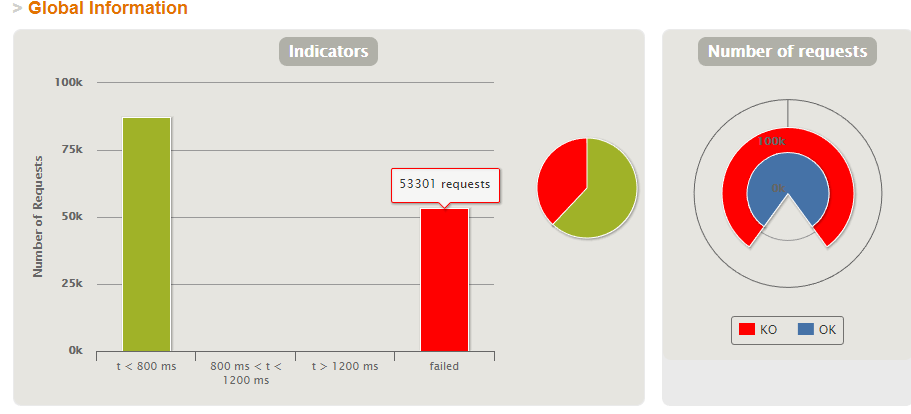Gatling初次体验
主要步骤:
1. 利用springboot编写了一个简单的服务jdktest
2.将jdktest利用docker在虚拟机中启动
3.创建一个scala工程,利用gatling提供的DSL编写性能脚本
4.执行并查看报告
1.编写jdktest服务
接口名称:/common/check
1 参数:一个User对象 2 3 格式: json 4 5 响应: 7 年龄小于等于30,结果:{"code":200,"msg":"success","data":{"name":"hello","age":18}} 8 年龄大于30,结果:{"code":400,"msg":"年龄大于30","data":{"name":"hello","age":50}}


2.部署服务
将jdktest打成jar包,并上传到服务器(我这里是虚拟机,并且已经安装了docker)上,在jar同级目录下创建Dockerfile
FROM primetoninc/jdk:1.8 MAINTAINER 3404924705@qq.com ADD jdktest-0.0.2-SNAPSHOT.jar /usr/local/jdktest/ RUN mkdir /usr/local/jdktest/log RUN chmod -R 755 /usr/local/jdktest WORKDIR /usr/local/jdktest EXPOSE 19801 ENTRYPOINT java -jar jdktest-0.0.2-SNAPSHOT.jar
然后在Dockerfile所在路径执行下面的命令,来创建镜像、启动容器以及运行服务
创建镜像(注意后面的路径“.”,下面的镜像名称是jdktest) docker build -t jdktest:1.2 . 运行容器(下面的容器名称是cjdktest,宿主机上的日志路径是/usr/local/my/log) docker run -d -p 8081:8081 -v /usr/local/my/log:/usr/local/jdktest/log --name cjdktest jdktest:1.2 如果出现log文件没有权限的问题,可能原因centos7中安全模块selinux把权限禁掉了 可以使用下面的命令 docker run -d -p 8081:8081 -v /usr/local/my/log:/usr/local/jdktest/log --privileged=true --name cjdktest jdktest:1.2
3.编写性能脚本(如果使用Gatling执行器来执行脚本,那么就可以跳过安装scala的开发环境)
3.1 安装scala的开发环境
本例中使用的是scala 2.12.8
参考:
https://www.runoob.com/scala/scala-install.html
3.2 配置IDEA,并创建scala工程
安装scala插件,下面安装完成后的截图。

创建scala项目


右击项目,选择Add FrameWorker support
选择maven

修改pom.xml
1 <?xml version="1.0" encoding="UTF-8"?> 2 <project xmlns="http://maven.apache.org/POM/4.0.0" 3 xmlns:xsi="http://www.w3.org/2001/XMLSchema-instance" 4 xsi:schemaLocation="http://maven.apache.org/POM/4.0.0 http://maven.apache.org/xsd/maven-4.0.0.xsd"> 5 <modelVersion>4.0.0</modelVersion> 6 7 <groupId>groupId</groupId> 8 <artifactId>gatlingtest</artifactId> 9 <version>1.0-SNAPSHOT</version> 10 <properties> 11 <maven.compiler.source>1.8</maven.compiler.source> 12 <maven.compiler.target>1.8</maven.compiler.target> 13 <encoding>UTF-8</encoding> 14 15 <gatling.version>3.0.3</gatling.version> 16 <gatling-maven-plugin.version>3.0.1</gatling-maven-plugin.version> 17 </properties> 18 19 <dependencies> 20 <dependency> 21 <groupId>io.gatling.highcharts</groupId> 22 <artifactId>gatling-charts-highcharts</artifactId> 23 <version>${gatling.version}</version> 24 </dependency> 25 <dependency> 26 <groupId>io.gatling</groupId> 27 <artifactId>gatling-app</artifactId> 28 <version>${gatling.version}</version> 29 </dependency> 30 <dependency> 31 <groupId>io.gatling</groupId> 32 <artifactId>gatling-recorder</artifactId> 33 <version>${gatling.version}</version> 34 </dependency> 35 </dependencies> 36 37 38 <build> 39 <plugins> 40 <plugin> 41 <groupId>org.scala-tools</groupId> 42 <artifactId>maven-scala-plugin</artifactId> 43 <version>2.15.2</version> 44 <executions> 45 <execution> 46 <goals> 47 <goal>compile</goal> 48 <goal>testCompile</goal> 49 </goals> 50 </execution> 51 </executions> 52 </plugin> 53 <plugin> 54 <groupId>io.gatling</groupId> 55 <artifactId>gatling-maven-plugin</artifactId> 56 <version>3.0.1</version> 57 <configuration> 58 <!-- 测试脚本 --> 59 <simulationClass>computerdatabase.ApiJdkTest</simulationClass> 60 <!-- 结果输出地址 --> 61 <resultsFolder>D:\z_softinstall\intellijidea\IdeaProjects\gatlingtest\report</resultsFolder> 62 </configuration> 63 </plugin> 64 </plugins> 65 </build> 66 67 </project>
注意修改gatling-maven-plugin的配置,simulationClass代表执行的是哪个脚本,resultsFolder表示报告的存放目录
将src目录下的文件和文件夹删除
选中src目录右击 选中MarkDirectory as 再选中Sources root
在src下面创建一个package 命名为computerdatabase(这个包名是gatling例子中的名称,同时也是gatling执行器中例子脚本存放的目录名称)
在该目录下创建一个scala文件 ApiJdkTest(这个名称要和pom.xml中simulationClass的配置对应起来,不然执行时会报找不到测试脚本)
编写脚本
1 package computerdatabase 2 3 import io.gatling.core.Predef._ 4 import io.gatling.http.Predef._ 5 import scala.concurrent.duration._ 6 7 class ApiJdkTest extends Simulation { 8 9 //给年龄字段添加一个随机数Feeder 10 //使用Feeder的原因:按照gatling的官方文档的解释,由于DSL会预编译,在整个执行过程中是静态的。因此Random在运行过程中就已经静态化了,不会再执行。 11 //参考:https://www.jianshu.com/p/7f7a57a8c2bb 12 val randomIdFeeder = 13 Iterator.continually(Map("age" -> 14 (scala.util.Random.nextInt(50)))) 15 16 //设置请求的根路径 17 //这里是在虚拟机中jdktest的服务地址 18 val httpConf = http.baseUrl("http://192.168.1.3:19801") 19 20 /* 21 运行秒数 during 默认单位秒,如果要用微秒 during(100 millisecond) 22 下面内容可以参考: 23 脚本结果:https://gatling.io/docs/current/general/concepts/ 24 post请求:https://gatling.io/docs/current/http/http_request/ 25 check:https://gatling.io/docs/current/http/http_check/#http-check 26 */ 27 val scn = scenario("JdkTest") 28 .during(100) { 29 forever( 30 feed(randomIdFeeder) 31 .exec(http("UserCheck") 32 .post("/common/check") 33 .header("Content-Type", "application/json") 34 .body(StringBody(s"""{"name":"hello","age":""" + "${age}" +"""}""")).asJson 35 .check(status.is(200)) 36 .check(jsonPath("$.code").is("200")) 37 .check(jsonPath("$.msg").is("success")) 38 ) 39 ) 40 } 41 /* 42 设置并发 43 参考 44 https://gatling.io/docs/current/general/simulation_setup/ 45 */ 46 setUp( 47 scn.inject( 48 //在20秒内以线性斜坡方式完成注入20的用户,不是一下子注入20个,而是逐步增加(线性)。可以从报告看出。 49 rampUsers(20) during (20 seconds) 50 ).protocols(httpConf) 51 ) 52 }
执行脚本
View-》Tool Windows-》Maven Projects 选择gatling:test

执行完成后,会提示报告存放路径

查看报告
下面是成功和失败(这里只包含check结果)的统计结果

下面是响应
橙色的线表示用户数,可以看到从左侧开始,是逐步将用户数增加到20的
其它的代表响应时间

本文来自博客园,作者:月色深潭,交流群:733423266,转载请注明原文链接:https://www.cnblogs.com/moonpool/p/11334609.html


